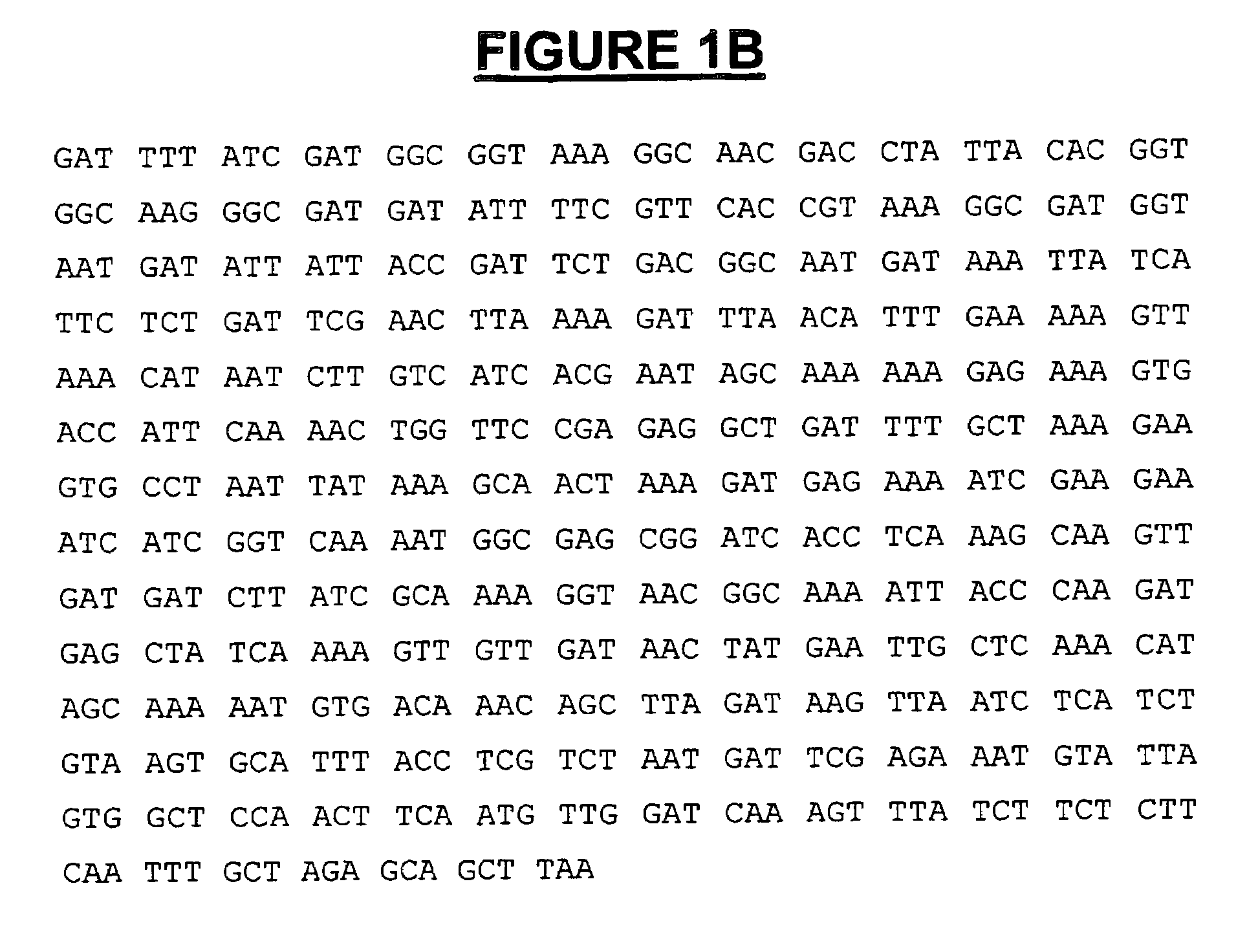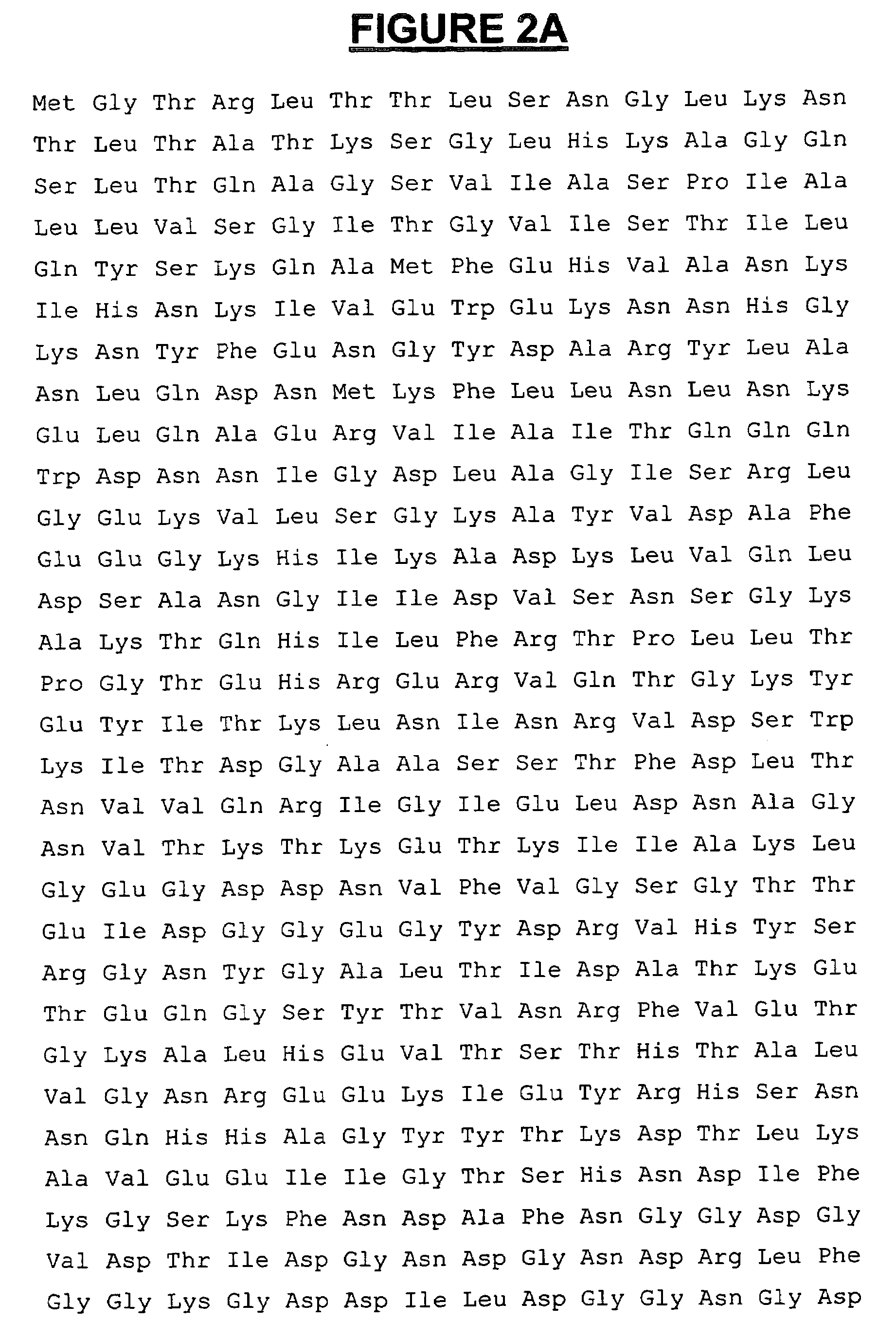Modified leukotoxin gene and protein
a technology of leukotoxin and gene, which is applied in the field of construction and expression of a modified leukotoxin gene, can solve the problems of unstable and rapid degradation, difficult and costly purification and characterization of these antigens, and general failure of immunization with live i>m. haemolytica /i>vaccines, etc., and achieves the effect of avoiding toxic activity and higher levels
- Summary
- Abstract
- Description
- Claims
- Application Information
AI Technical Summary
Benefits of technology
Problems solved by technology
Method used
Image
Examples
example 1
[0161]The modified leukotoxin gene IktAΔN was prepared by deleting the hydrophobic domains of the full length M. haemolytica leukotoxin gene containing nucleotides 618 to 1653. The nucleic acid sequence and amino acid sequence of IktAΔN is shown in FIGS. 1A and 1B and 2A and 2B, respectively. The IktAΔN was cloned into an expression plasmid (pTTQ18) which placed the regulation of expression under the inducible tac promoter. In the presence of another plasmid, pWAM716 which coded for the hlyB / D secretion functions, the rLkt is secreted into the supernatant of E. coli cultures for ease of recovery.[0162]1. An E. coli strain that carries both plasmids, pLKTAN and pWAM716, was used. As controls, E. coli carrying pWAM761 and pLKT60 (full length IktA); and E. coli carrying pWAM716 and pTTQ18 (no iktA gene) were also used as positive and negative controls respectively. All strains were maintained on LT supplemented with ampicillin (100 μg / ml) and chloroamphenicol (25 μg / ml) to select for t...
example 2
1. Construction of IktA50
[0184]A derivative of Lkt66 (Lkt50) was made by further manipulation of the IktAΔN construct. PCR primers based on the IktA sequences at positions 1355 and 2705 were designed to amplify a fragment of 1.35 kbp. This fragment codes for all of the antigenic regions of Lkt66, lacking the N-terminal portion of the protein. The removal of the N-terminal amino acids of Lkt66 facilitates expression of the toxin derivative in plants. This construct, named Ikt50should produce a protein from amino acids 451 to 901 of the full length leukotoxin, for a molecular mass of 49.6 kDa, slightly less than half of the full length leukotoxin of 102 kDa. The corresponding amino acid regions are:[0185]phe-leu-leu-asn-leu-asn-lys-glu-leu-gln . . . leu-ser-lys-val-val-asp-asn-tyr-glu-
[0186]Note that the last amino acid glu is continued into the GFP protein.
2. Cloning of Ikt50 into a Binary Vector
[0187]A binary vector pBINmgfp5-ER was used for cloning of the Ikt50fragment and introduc...
PUM
| Property | Measurement | Unit |
|---|---|---|
| Nucleic acid sequence | aaaaa | aaaaa |
| Immunogenicity | aaaaa | aaaaa |
Abstract
Description
Claims
Application Information
 Login to View More
Login to View More - R&D Engineer
- R&D Manager
- IP Professional
- Industry Leading Data Capabilities
- Powerful AI technology
- Patent DNA Extraction
Browse by: Latest US Patents, China's latest patents, Technical Efficacy Thesaurus, Application Domain, Technology Topic, Popular Technical Reports.
© 2024 PatSnap. All rights reserved.Legal|Privacy policy|Modern Slavery Act Transparency Statement|Sitemap|About US| Contact US: help@patsnap.com










